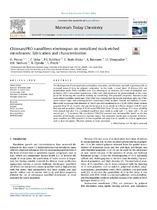Chitosan/PEO nanofibers electrospun on metallized track-etched membranes: fabrication and characterization
Abstract
The development of next-generation adsorption, separation, and filtration materials is growing with an increased research focus on polymer composites. In this study, a novel blend of chitosan (CS) and polyethylene oxide (PEO) nanofiber mats was electrospun on titanium (Ti)-coated polyethylene terephthalate (PET) track-etched membranes (TMs) with after-treatment by glutaraldehyde in the vapor phase for enhancing the nanofiber stability by crosslinking. The prepared composite, titanium-coated track-etched nanofiber membrane (TTM-CPnf) was characterized by Fourier transform infra-red (FTIR), water contact angle, and scanning electron microscopy (SEM) analyses. Smooth and uniform CS nanofibers with an average fiber diameter of 156.55 nm were produced from a 70/30 CS/PEO blend solution prepared from 92 wt. % acetic acid and electrospun at 15 cm needle to collector distance with 0.5 mL/h flow rate and an applied voltage of 30 kV on the TTM-CPnf. Short (15 min) and long (72 h)-term solubility tests showed that after 3 h, crosslinked nanofibers were stable in acidic (pH = 3), basic (pH = 13), and neutral (pH = 7) solutions. The crosslinked TTM-CPnf material was biocompatible based on the low mortality of freshwater crustaceans Daphnia magna. The composite membranes comprised of electrospun nanofiber and TMs proved to be biocompatible and may thus be suitable for diverse applications such as dual adsorption–filtration systems in water treatment.

